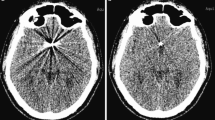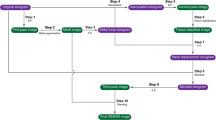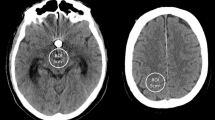Abstract
Introduction
Flat-panel angiographic CT after intravenous contrast agent application (ivACT) is increasingly used as a follow-up examination after coiling, clipping, or stenting. The purpose of this study was to evaluate the feasibility of a new metal artefact reduction algorithm (MARA) in patients treated for intracranial aneurysms and stenosis.
Methods
IvACT was performed on a flat-panel detector angiography system after intravenous application of 80 ml contrast media. The uncorrected raw images were transferred to a prototype reconstruction workstation where the MARA was applied. Two experienced neuroradiologists examined the corrected and uncorrected images on a commercially available workstation.
Results
Artefacts around the implants were detected in all 16 uncorrected cases, while eight cases showed remaining artefacts after correction with the MARA. In the cases without correction, there were 11 cases with “extensive” artefacts and five cases with “many” artefacts. After correction, seven cases showed “few” and only one case “many” artefacts (Wilcoxon test, P < 0.001). Parent vessels were characterized as “not identifiable” in 62 % of uncorrected images, while the delineation of parent vessels were classified as “excellent” in 50 % of the cases after correction (Wilcoxon test, P = 0.001).
Conclusions
Use of the MARA in our study significantly reduced artefacts around metallic implants on ivACT images and allowed for the delineation of surrounding structures.



Similar content being viewed by others
References
Doelken M, Struffert T, Richter G, Engelhorn T, Nimsky C, Ganslandt O, Hammen T, Doerfler A (2008) Flat-panel detector volumetric CT for visualization of subarachnoid hemorrhage and ventricles: preliminary results compared to conventional CT. Neuroradiology 50:517–523
Soderman M, Babic D, Holmin S, Andersson T (2008) Brain imaging with a flat detector C-arm: technique and clinical interest of XperCT. Neuroradiology 50:863–868
Psychogios MN, Buhk JH, Schramm P, Xyda A, Mohr A, Knauth M (2010) Feasibility of angiographic CT in peri-interventional diagnostic imaging: a comparative study with multidetector CT. AJNR 31:1226–1231
Buhk JH, Lingor P, Knauth M (2008) Angiographic CT with intravenous administration of contrast medium is a noninvasive option for follow-up after intracranial stenting. Neuroradiology 50:349–354
Psychogios MN, Schramm P, Buhk JH, Xyda A, Groschel K, Jung K, Knauth M (2010) Angiographic CT after intravenous contrast agent application: a noninvasive follow-up tool after intracranial angioplasty and stenting. AJNR 31:1886–1891
Struffert T, Kloska S, Engelhorn T, Deuerling-Zheng Y, Ott S, Doelken M, Saake M, Kohrmann M, Doerfler A (2011) Optimized intravenous flat detector CT for non-invasive visualization of intracranial stents: first results. Eur Radiol 21:411–418
Psychogios MN, Wachter D, Mohr A, Schramm P, Frolich AM, Jung K, Rohde V, Knauth M (2011) Feasibility of flat panel angiographic CT after intravenous contrast agent application in the postoperative evaluation of patients with clipped aneurysms. AJNR 32:1956–1962
Clarencon F, Piotin M, Pistocchi S, Babic D, Blanc R (2012) Evaluation of stent visibility by flat panel detector CT in patients treated for intracranial aneurysms. Neuroradiology 54:1121–1125
Prell D, Kyriakou Y, Struffert T, Dorfler A, Kalender WA (2010) Metal artifact reduction for clipping and coiling in interventional C-arm CT. AJNR 31:634–639
Meyer E, Raupach R, Lell M, Schmidt B, Kachelriess M (2010) Normalized metal artifact reduction (NMAR) in computed tomography. Med Phys 37:5482–5493
Kyriakou Y, Struffert T, Dorfler A, Kalender WA (2009) Basic principles of flat detector computed tomography (FD-CT). Radiologe 49:811–819
Mordasini P, El-Koussy M, Brekenfeld C, Schroth G, Fischer U, Beck J, Gralla J (2012) Applicability of tableside flat panel detector CT parenchymal cerebral blood volume measurement in neurovascular interventions: preliminary clinical experience. AJNR 33:154–158
Saake M, Struffert T, Goelitz P, Ott S, Seifert F, Ganslandt O, Doerfler A (2012) Angiographic CT with intravenous contrast agent application for monitoring of intracranial flow diverting stents. Neuroradiology 54:727–735
Dehdashti AR, Binaghi S, Uske A, Regli L (2006) Comparison of multislice computerized tomography angiography and digital subtraction angiography in the postoperative evaluation of patients with clipped aneurysms. J Neurosurg 104:395–403
Acknowledgments
The department has a Research Agreement with Siemens AG, Forchheim, Germany.
Conflict of interest
MNP has received support from Siemens AG (money paid to institution) for basic flight and hotel accommodation expenses for RSNA 2011, Chicago, and ASNR 2012, New York. PS and MK have received speaker's honoraria from Siemens AG. BS and YK are employees of Siemens AG. CR consults for Siemens AG.
Author information
Authors and Affiliations
Corresponding author
Additional information
This paper was first presented during the ASNR 50th Annual Meeting & The Foundation of the ASNR Symposium 2012, New York, April 21-26, 2012.
Rights and permissions
About this article
Cite this article
Psychogios, MN., Scholz, B., Rohkohl, C. et al. Impact of a new metal artefact reduction algorithm in the noninvasive follow-up of intracranial clips, coils, and stents with flat-panel angiographic CTA: initial results. Neuroradiology 55, 813–818 (2013). https://doi.org/10.1007/s00234-013-1165-6
Received:
Accepted:
Published:
Issue Date:
DOI: https://doi.org/10.1007/s00234-013-1165-6




